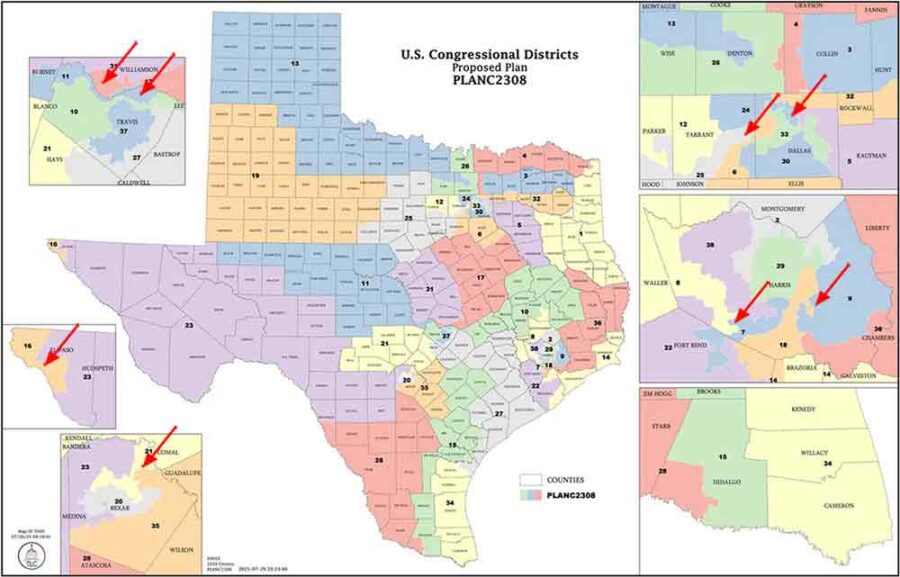It seems we didn’t have enough chaos and blood on the national carpet.
|
Listen To This Story
|
It’s being called a political nuclear war.
By now, it’s common knowledge that Donald Trump has turned up the heat on red states like Texas, Missouri, Florida, and Ohio to get cracking on an unprecedented mid-decennial redistricting, with the aim of netting the Republican Party enough additional seats to hold the US House in the 2026 midterms.
And it’s no secret, either, that those states have scurried to comply, or that blue states like California, Illinois, and New York are gearing up to “retaliate” by undertaking their own redistricting to forge more robust Democratic majorities in their state delegations.
The only mystery is that expressed to me by a reasonably savvy friend, who said, “Wait, I thought all those states already were gerrymandered! How much worse can it get?”
The answer is: a lot worse. And here’s why.
Picture yourself with control over the redistricting process in your state — for these purposes, a state with a sizable House delegation, yielding a lot of geographical options. Call the two major parties, for the purpose of this exercise, the Yellow and Pink parties. You work for the Yellow Party, which has control over both houses of the state legislature and the governorship, and you have been tasked with redrawing the district lines for the US House delegation.
You have a few constraints, courtesy of established constitutional interpretation, the 1965 Voting Rights Act, and state law: Each district must be contiguous (no free-floating pieces separated from the main body) and the state population must be roughly evenly apportioned among however many districts the state is allotted by the results of the last census. And you have to be careful not to draw egregiously racially discriminatory district lines.
It couldn’t have been more obvious that — with state legislatures left to their own devices and free of judicial oversight — partisan gerrymandering would have a field day. Rucho, in effect, split the atom, making possible the current nuclear war.
But John Roberts’s Supreme Court, by a 5–4 party-line decision in Rucho v. Common Cause (2019), effectively greenlighted drawing the lines for maximum partisan advantage — calling it a “political question” in which the federal courts must take no part.
Roberts, who wrote the Rucho opinion, apparently couldn’t see, or chose to ignore, the absurdity of counting on state legislatures to set their own limits on the very process by which majorities not only locked themselves into power but created all those safe seats, both in the US House and their own state chambers, that all but guaranteed reelection for most incumbents of both parties.
Why, Mr. Chief Justice, would state legislators not gerrymander to avoid competitive elections for their own seats?
It couldn’t have been more obvious that — with state legislatures left to their own devices and free of judicial oversight — partisan gerrymandering would have a field day. Rucho, in effect, split the atom, making possible the current nuclear war.
Up until now, your approach would of course have been to gerrymander the districts for the Yellow Party’s advantage — this is made clear by looking at state maps and ratios of House seats held by each party relative to the statewide vote. But you almost certainly would have done so in a way that created lots of safe (i.e., noncompetitive) seats for both parties.
You would have done this not out of the kindness of your heart but in order to gain the bipartisan buy-in that would ensure the minimal amount of grumbling and challenges from whichever party was out of power.
As a result, America has a House (with 435 voting members) in which something on the order of 90 percent of its members, on both sides of the aisle, have safe seats, don’t really have to campaign much (except, perhaps, in dreaded party primaries), and are personally happy with the whole set-up.
So, in any biennial election, realistically only about 40–50 House seats out of 435 are in play — with only about half of those considered genuine toss-ups — and House majorities generally swing back and forth based on that very thin slice of the national pie.
The vast majority of American voters, for all intents and purposes, have no voice in which party controls the House, supposedly the most representative body of the federal government.
Another consequence of partisan gerrymandering has been an increasingly polarized and paralyzed House. Why? Because in all those safe seats the only elections of any consequence are the party primaries. And because the electorate in primaries is strongly weighted to ideologically motivated voters, more extreme candidates either win primaries — and then, of course, the noncompetitive general election — or push moderate candidates to themselves become more extreme to fend off such challenges.
In the GOP particularly, a mere hint from Trump that he will field or support a primary challenger for one’s seat is enough to whip any “moderate” or wavering member into line — or prompt their retirement.
The result is a more ideologically polarized, lockstep House, in which bipartisan consensus or even compromise have become increasingly rare — a major source of its recent chronic dysfunction as a body.
When Ordinary Pernicious Gerrymandering Isn’t Enough
So, you’ve gone about your business, as have your counterparts in the Pink Party in the states where it has control, and the result is a stagnant House, prone to polarization, with narrow majorities, little chance of compromise or bipartisanship, and one in which only a small sliver of voters determine control.
Congratulations on all that dysfunction! What can you possibly do to make it worse?
Well, last week you got a call from President Trump, who got right down to cases.
“I’ve had the GREATEST six months of any president or dictator in history,” quoth he (in my nonhallucinatory imagination), “but the FAKE POLLS seem to be saying that the fans out there are slow on the uptake. What can you do, it’s the FAKE MEDIA, but they’re all saying I’m under some deep water approval-wise, still sinking, and now this Epstein thing, the creep. And Powell with his interest rates, and Bibi, and Putin, and who knows who, fucking things up for me.
“There’s only so much MY COURT can do! We’re down FIVE in the latest Generic Congressional Ballot, whatever the hell that is!!
“What I’m getting at here is I need a little help from you — actually a lot of help — to hang onto the House (God help me if those RADICAL LEFT LUNATICS get hold of the House!).
“You know what to do. Get into those maps, get out your Sharpies, and redraw what you gotta redraw. I want five more seats from your great state (which I made great again), so squeeze that lemon and find them for me. Just do it, OK?!”
So you got to work, squiggled a bunch of lines on the map, and guess what? In your state, five US House seats just magically shifted from the Pink to the Yellow party — in terms of expected outcomes in next year’s midterm elections.
Any resemblance here to Texas, where Trump says he is “entitled to five more seats,” is strictly intentional.
Where There’s a Will…
How did you do it? Well, to explain this magical result we have to dig a little deeper into the weeds of politico-mathematical hocus-pocus. You start with a given population, a given overall partisan divide, a given number of districts, and the rules (such as they are) you have to play by — and then you turn the crank of some handy mathematical formulas that allow you to calculate the maximal partisan advantage you can squeeze out of that particular lemon.
The newly proposed Texas map is the spawn of that optimization algorithm.
Texas has 38 congressional districts, whose representatives are currently divided 25–13 in favor of the Republican Party. In percentage terms that’s a 66–34 percent GOP advantage — a partisan divide unchanged since the 2022 election.
Because there are a number of uncontested seats — courtesy of gerrymandering — for which vote totals are not even tabulated, you can’t simply add up all the US House results to get the actual vote totals statewide. So we use adjacent statewide races as a stand-in: In this case, the governor’s contest in 2022 and US Senate contest in 2024 — the averaged margin in those two contests being 9.7 points: 54.0 percent Republican to 44.3 percent Democratic.
The existing maps, drawn on the basis of the 2020 Census, boost the GOP from that 9.7 point (54.0–44.3) statewide electoral majority to a 32 point (66–34) US House delegation majority.
A pretty neat anti-democratic (and anti-Democratic) trick — but not enough for Donald Trump.
The new map, drawn to his demand, would, if all goes as expected, expand the GOP’s US House majority in Texas to 30–8. That’s 79 to 21 percent of the seats, a 58 point margin magically fabricated from that same 9.7 point statewide advantage.
And this is how it’s done. You begin by identifying the few competitive seats currently held by Democrats, in this case five. To flip them, you simply need to redraw those districts such that they exchange some reliably Democratic precincts for some reliably Republican precincts.
You can get those Republican precincts/voters from one or more neighboring “safe” districts — either safe Republican districts where they are not needed or safe Democratic districts where the minority of Republican voters will never result in a GOP win.
You are more likely to siphon them from safe Republican districts because, if you’ve done your gerrymandering job in the past (which, of course, Texas Republicans have, though they did manage to leave five bites of meat on the T-bone), there will be very, very few Republican voters in the safe Democratic districts you “packed” — that’s the technical term for it — with as close to 100 percent Democratic voters as possible.
And you can move those Democratic voters in the target districts into either a safe Republican or a safe Democratic district where they’ll do no harm to your party.
Voila! Five more Republican-leaning districts for Trump — a net shift of 10 seats in the House.
Catch 38?
Of course, there is a bit of a catch. To get to that 30-to-8 shellacking demanded by Trump, you have to cut the hocus-pocus pretty fine. You must avoid endangering your own Republican incumbents in their safe seats by leeching too many Republican voters from them, or moving too many Democratic voters into them, which would risk turning them into — perish the thought! — competitive races.
And you should avoid any juggling that suggests racial motivation, an effort to dilute and diminish the representation of voters of color — which the Supreme Court has said is, for now at least, still a no-no.
And, finally, you want to build in some electoral breathing room, in case even more voters sour on Trump and his MAGA/GOP, enough to shift the overall electorate substantially to the left, giving rise to a blue “wave” election like the 2018 midterms. At its most extreme, such a shift could endanger not just the newly minted five leaning-Republican competitive seats, but perhaps even a previously safe seat or two that your handiwork made slightly less safe.
Turbo-Gerrymandering
But fear not! Gerrymandering, once something of an art, has morphed into a pure science — and a ruthless one at that.
Big data and your supercomputers will enable you to identify Democratic and Republican neighborhoods, streets, blocks, and even houses with such precision that you will have little doubt just how many of which kind of voters you are moving where.
And they will also allow you to exercise great care in the color of voters you’re leeching and packing, fortifying your map against race-based legal challenges under what is left of the 1965 Voting Rights Act.
As for the frightful prospect of a blue wave election turning some safe GOP-held seats marginally competitive, well, it’s not for nothing that Texas is a veritable beacon of targeted voter suppression.
In a metaphorical parallel to the development and deployment of nuclear weapons that ended World War II and kicked off the Cold War, pushing the button on a map like this all but ensures the advent of a deadly (to democracy) redistricting arms race. But unlike nuclear stockpiles, these maps are not a weapon kept in reserve by the threat of mutual assured destruction (MAD); Trump has already given the “Go” code to launch.
Here is the proposed Texas map, along with an in-depth analysis of its impacts and prospects of surviving the inevitable state court challenges (remembering that Rucho has closed the doors of the federal courts to any challenge that is not based explicitly on racial grounds):

Note all the little coves and peninsulas, the isthmuses and tiny tendrils, especially around major metropolitan areas like Houston and Dallas. These are the visible fingerprints of extreme and politically ruthless precision, such as would have made Elbridge Gerry — who ironically found the practice that took his name “distasteful” — green with envy.
It is hard to imagine a more anti-democratic process, short of simply rigging vote counts or cancelling elections.
Bombs Away!
In a metaphorical parallel to the development and deployment of nuclear weapons that ended World War II and kicked off the Cold War, pushing the button on a map like this all but ensures the advent of a deadly (to democracy) redistricting arms race. But unlike nuclear stockpiles, these maps are not a weapon kept in reserve by the threat of mutual assured destruction (MAD); Trump has already given the “Go” code to launch.
The Democratic minority in the Texas state Legislature has responded — as it had, unsuccessfully, once before — by fleeing the state to deny the GOP majority a quorum needed to transact business and enact its new masterpiece of a map. Texas Gov. Greg Abbott (R) issued a call for the absent Democrats’ arrest and the FBI has been called in to track them down — they are currently on the lam and holed up in Illinois and Massachusetts — and haul them back.
These extraordinary measures from both sides should leave no doubt as to the stakes of the internal war into which Trump has plunged our country.
The odds are that the Democratic quorum gambit will fail, as will legal challenges to the maps brought in GOP-dominated Texas state courts. And while the Democrats can caterwaul and try to make political hay out of the “theft” of their red-state seats, such patriotic appeals to America’s democratic traditions, which have largely fallen flat throughout the Trumpocene, won’t change the carefully engineered partisan imbalances of the squiggly new districts in Texas and in the other red states dutifully answering Trump’s latest “find me the votes” call.
The 20-plus-seat net shift the GOP stands to gain from Texas, Florida, Ohio, Missouri, and Indiana will make a Democratic takeover of the House in 2026 an all but vertical hill to climb.
Knowing this, the Democrats are turning, reluctantly, to their own weapons factories, threatening to redraw the district lines in blue states where they have control, to counter, at least in part, Trump’s ploy.
They are hampered in this tactic, however, by their own prior efforts at fairness and good governance (alas, no good deed goes unpunished), which resulted in the writing of bipartisan independent redistricting commissions into several large blue-state constitutions. For obvious reasons, these pose an obstacle, in states like California and New York, to highly partisan legislative efforts to hit back by redrawing their maps.
While various workarounds have been proposed, it is not clear whether a redistricting in, say, California, designed to recoup the five Democratic seats lost in Texas (and triggered only in the event Texas goes through with its new maps), would survive legal challenge.
There is also the logistical problem that it is easier — for a combination of geographical, geometrical, and demographic reasons — to “pack” urban voters into near-100 percent Democratic districts than to do the equivalent for rural and suburban Republican voters, making it hard, if not impossible, for blue states to fully match red states in maximalist gerrymandering.
So the consensus among handicappers thus far is that this new war will result in a major GOP advantage.
Ugly and Getting Uglier
But evidently that is still not enough for Trump, who announced this week that he had instructed the Census Bureau to conduct a new, rogue, interdecennial census, from which undocumented immigrants are to be excluded. The fact that the Constitution specifies only decennial (every 10-years) censuses, gives the power to commission and fund them to Congress, and specifies as well that the Census must count all persons without exception? Trump is not troubled — after all, it is just the rule of law, which he has been having a blast ignoring and defying in a myriad of ways.
Gerrymandering — like the Electoral College and the two-senators-per-state set-up — has long played a distorting role in American democracy, causing some votes and voters to matter far more than others, and boosting the power of one party or another and their constituencies.
One can say that all three are venerable parts of the political game to which parties and politicians have had to adapt. (The Senate and Electoral College are mandated in the US Constitution, and gerrymandering dates to 1812.)
But even one glance at the proposed Texas map, above, should be enough to tell us that something is very wrong with this picture, a new and extreme distortion of the principle and practice of representative democracy.
The fact that it is yet another anti-democratic blow struck by an anxious Donald Trump, in service to his own lust for absolute power, does not improve matters.
Whether Trump gets anywhere with his demand for a new census, and however the various maps shake out, we are unmistakably in what amounts to the nuclear age of American politics — lacking even the dubious restraints of MAD.
We should not, therefore, be taken by surprise by literally any schemes to rig our upcoming critical elections, up to and including all the methods that have been used in the “managed” “democracies” run by the dictators, like Vladimir Putin and Viktor Orban, that Trump so admires.
This is what political total war looks like. It is ugly, getting uglier, and not for the faint of heart.




